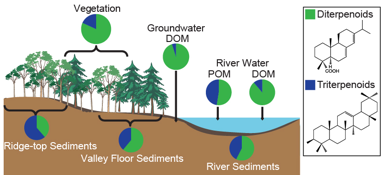Reports: DNI251787-DNI2: Terrestrial Biomarker Transport Mechanisms and Implications for Interpreting Terrestrial Biomarker Signals in Oils and Bitumens
Aaron F. Diefendorf, PhD, University of Cincinnati
1) Plant terpenoids: from source to sink in a modern river system. A team of researchers (the PI, MS student Sharmila Giri, and two undergraduate students) collected samples from modern plants, waters, and sediments within the Miners River watershed (Fig. 1); a small protected watershed in Picture Rocks National Lakeshore in the Upper Peninsula of Michigan. This watershed was chosen because the vegetation was extensively surveyed and has remained relatively undisturbed for the last ~50 years. Within the watershed, we found that the ratio of diterpenoids (conifers) to triterpenoids (angiosperms) in the plants was not reflected in the river sediments (Fig. 2); sediments contained less diterpenoids than expected. This is likely attributed to a combination of processes that preferentially remove and/or degrade diterpenoids. As part of this project, Ms. Giri developed a new method to analyze biomarkers in dissolved organic matter in river waters. Until now, few studies had studied dissolved biomarkers due to the low concentrations in natural waters and the complex chemistry of dissolved organic matter. This new method uses solid-phase extraction to isolate and quantitatively remove the dissolved biomarkers from river water in combination with gas chromatography mass-selective ion-monitoring mass spectrometry. Excitingly, we found both di- and triterpenoids in dissolved organic matter fractions, but the ratio of these compounds was higher than expected, possibly reflecting the higher solubility of diterpenoids in water (Fig. 2). This project was completed by Ms. Giri as part of her MS thesis, was presented at three national conferences, and is currently in review for publication.
Figure 1. The Miners River is a small headwater stream draining a mixed conifer and angiosperm forest in the Upper Peninsula of Michigan.
Figure 2. A cross section of the Miners River drainage valley and terpenoid pie graphs indicating the relative concentrations in various reservoirs including particulate organic matter (POM) and dissolved organic matter (DOM).
2) Simulated terpenoid alteration with hydrous pyrolysis. Plant biomarkers, such as leaf waxes and terpenoids, and their carbon isotopes, are important tools to quantitatively reconstruct paleovegetation and paleoclimate. However, the fate of these compounds in the geosphere is uncertain. We know that biomarkers are altered and degraded during organic matter diagenesis and many degradation pathways have been mapped out. However, recent geologic studies and our Miners River study suggest preferential loss of some biomarker classes over others. To investigate the role of selective alteration and degradation, we (the PI and Doug Sberna, an undergraduate student) used hydrous pyrolysis to artificially mature specimens. We treated Acer rubrum, Pinus sylvestris, Platanus occidentalis and Taxodium distichum at temperatures ranging from 150 to 330C for 72 hours. The pyrolysates were solvent extracted, saponified, purified, derivatized, and analyzed by GC-MS. Our results indicate that leaf wax and di- and triterpenoid concentrations generally decrease with increasing temperatures, with the exception of degradation products. Interestingly, we observe that triterpenoid compounds are nearly absent by 250C as compared to diterpenoids that persist to higher temperatures (330C). These results are consistent with geologic studies, but are not consistent with the Miners River data. This project was Doug Sberna's senior research project and was presented by Sberna at the 2014 Goldschmidt meeting.
3) Biomarkers among conifer species. Leaf waxes and their carbon isotopes are commonly used to track past changes in the carbon cycle. Previous studies indicated that conifer leaf waxes (specifically n-alkanes) are lower in concentration than in angiosperms and that 13-C fractionation during n-alkane synthesis is smaller than in angiosperms. These prior studies, however, sampled only a few conifer genera and were limited to North America conifers. This ignored many important subtropical and Southern Hemisphere groups that were once widespread and common components of fossil assemblages. To expand on previous work, a team (the PI, Scott Wing, Andrew Leslie, and several undergraduate students) collected 44 conifer species from the University of California Botanical Garden at Berkeley, capturing all extant conifer families and most extant genera. By collecting all of the specimens at one site, the confounding effects of climate were minimized. Interestingly, we found that Pinaceae, including many North American species used in previous studies, have very low or no n-alkanes. However, other conifer groups have significant concentrations of n-alkanes, especially the Araucariaceae (Norfolk Island pines), Podocarpaceae (common in the Southern Hemisphere), and many species of Cupressaceae (junipers and relatives). We also found strong phylogenetic signals in n-alkane abundances and chain-lengths. These results have important implications for interpreting n-alkane carbon isotope values in sedimentary archives, especially outside of North America. This work will be presented at the 2014 AGU meeting.
Figure 3. n-Alkyl lipids in the leaf waxes of 44 conifer species grown at the University of California Botanical Garden at Berkeley.














